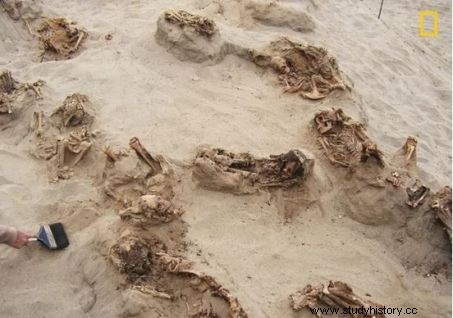The remains of 140 children sacrificed in the 15th th century during a mass ritual were exhumed in America, in a region where the pre-Columbian civilization of the Chimu was present.

The largest child sacrifice site in pre-Hispanic America has been discovered on the northern coast of Peru, in Huanchaquito.
PRE-COLUMBIAN CIVILIZATION. Some bodies were exposed, others had their skulls smeared with cinnabar giving them a blood-red appearance… 140 children and adolescents as well as 200 young lamas were immolated 550 years ago on the shores of the Pacific, in the heart of the Chimu empire , an important pre-Columbian civilization (1000 – 1470) prior to the Incas. A ceremony on a scale never before described. “I have studied many cases of sacrifices of prisoners of war, or of servants executed with their masters, but I had never seen anything like this !”, says John Verano, anthropologist at Tulane University (United States), joined by Sciences et Avenir . On April 26, 2018, National Geographic magazine yet reported the discovery of what is being touted as the largest identified case of child sacrifice.

General view of the sacrificial site of Huanchaquito, Peru. © Courtesy Oscar Gabriel Prieto/National Geographic
Radiocarbon analyzes date the massacre between 1400 and 1450
Baptized Huanchaquito-Las Llamas, the site where the small victims have in fact been regularly exhumed since 2011 is located near a road, in the middle of an urban area, on a height, about 300 m above the level of the sea, in the north of Peru. There, in the province of Trujillo, the radiocarbon dating of these human remains made it possible to locate the hecatomb between 1400 and 1450. With its share of macabre details. “Both human and animal skeletons bore traces of notches at the level of the sternum…indicating the opening of the chests of these children to extract the heart” , says John Verano. Because it is indeed a ritual of human sacrifice with cardiectomy – removal of the heart from the rib cage – which was practiced in Huanchaquito in the 15th th century on these children aged 5 to 14.

Case of cardiectomy (extraction of the heart) performed on one of the young victims whose face was covered with cinnabar pigment, at the Huanchaquito site. The rib cage was cut out. © Courtesy Oscar Gabriel Prieto/National Geographic
Never have so many young people been sacrificed at once
From the first discoveries in 2011, this research undertaken with the participation of French and Peruvian archaeologists had already attracted attention. “The number of bodies of children and lamas exhumed was completely unprecedented” , says Nicolas Gopfeart, a French archaeologist from the CNRS, who is currently studying another deposit of the same type. “Camelids were probably killed to 'accompany' children to the afterlife .” Some still wore around their necks the ropes that had been used to lead them. “These practices were known among the Incas, successors of the Chimus, or even the Mayas and the Aztecs, but never had so many young people been sacrificed at one time and on such a scale”, says John Verano.

American anthropologist John Verano examining the skeleton of an adolescent at the pre-Hispanic site of Huanchaquito, Peru. © Courtesy Oscar Gabriel Prieto/National Geographic
At its height, the Chimu Empire, whose capital Chan Chan is 1.5 km from the site of Huanchaquito, controlled a territory of almost a thousand kilometers along the Pacific coast. But what could have happened to bring these populations to perform such a gesture? A large mudslide released during excavations could provide a clue:torrential rains and major flooding on the usually arid coastline may be credited to an El Nino weather event particularly violent. (In 1982-1983, such an episode produced dramatic effects in northern Peru, where more than 250 cm of rain fell in a few months, destroying everything).

One of the 140 sacrificed children associated with a lama, at the Huanchaquito-Las Llamas site. © Courtesy Oscar Gabriel Prieto/National Geographic
Climate event and divine wrath
In the 15th th century, this type of calamity could have caused havoc in coastal fishing as well as in Chimu cultures, pushing the inhabitants of the region to such extremes. “Within the pre-Columbian populations, religion permeated the whole system of thought. There was no difference between natural and supernatural phenomena. For most of these men, nature could be terrifying, and climatic catastrophes synonymous with destruction and death. Both by their immediate ravages and by the famines which followed in these littoral desert regions” , explains archaeologist Claude Chauchat (CNRS), a specialist in the ancient settlement of the northern coast of Peru. Faced with the terror inspired by divine anger, the populations of the Pacific coast may have had recourse to human sacrifices in an attempt to appease the gods, and in the case of Huanchaquito, faced with the possible failure of other sacrifices, to offer them what they treasured most:their own children. "This ritual seems close to those of Capacocha, also practiced by the Incas later. Related to exceptional rainfall and natural events, these rites also involved sacrifices of children (usually the most beautiful or those belonging to caciques ), as well as specific colored llamas such as brown, white, or black, associated with different aspects of the creator deity:Wiracocha or its Chimu and coastal equivalent ", said Patrice Lecoq, lecturer in Andean archeology at Paris-I University. New research is currently being carried out under the direction of Oscar Gabriel Prieto, from the National University of Trujillo (Peru).
